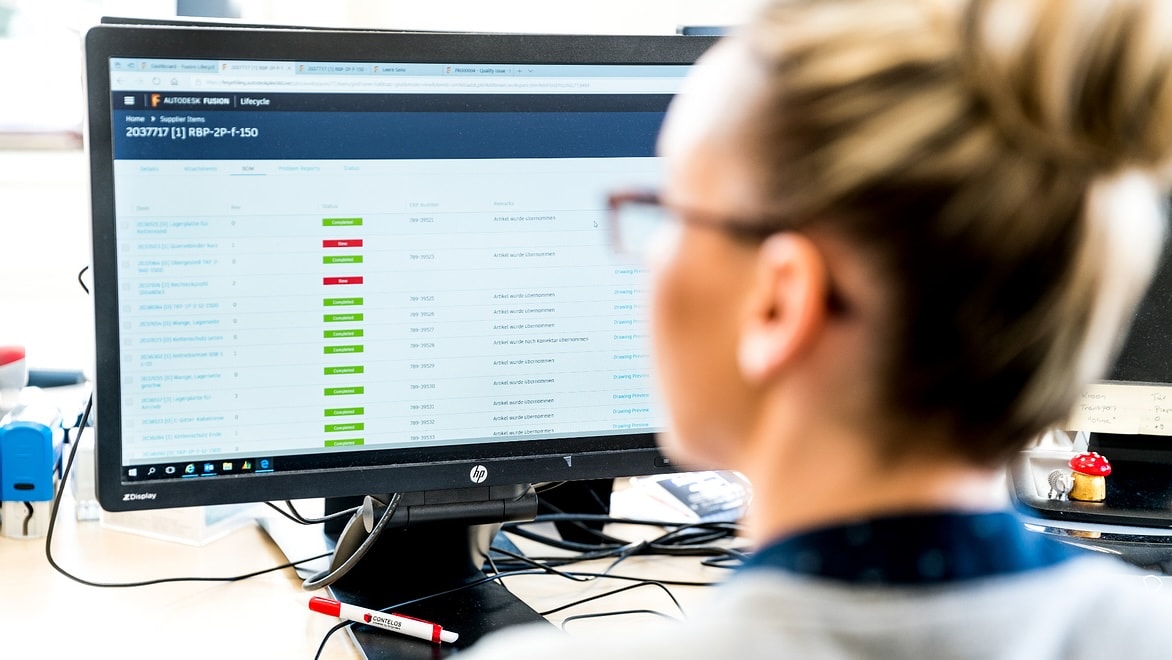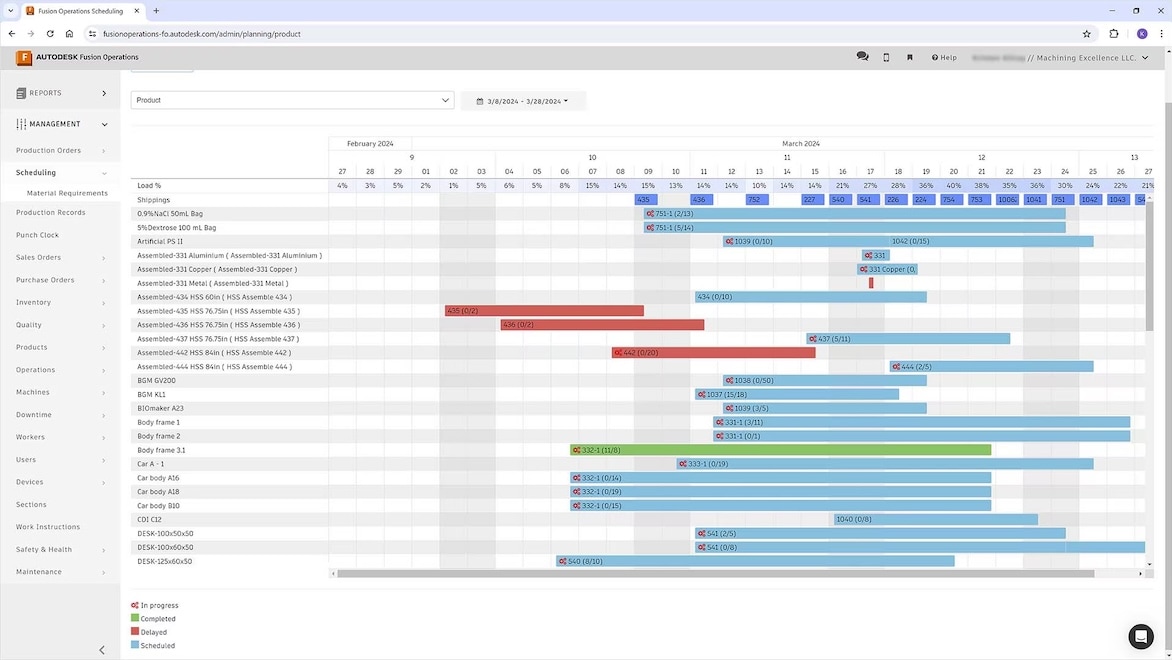& Construction

Integrated BIM tools, including Revit, AutoCAD, and Civil 3D
& Manufacturing

Professional CAD/CAM tools built on Inventor and AutoCAD
Process manufacturing describes the manufacturing of products—usually in bulk quantities—based on a set formula or recipe. Each step in the process must be completed before the next step, and in contrast to discrete manufacturing, finished products from process manufacturing cannot be disassembled into their component parts. Process manufacturing software can help at each step.
Process manufacturing can be broken down into two types: continuous and batch.
Continuous process manufacturing produces the same product (or group of products) nonstop, or as close to nonstop as needed, with no variations or customization. Examples of continuous process manufacturing include gasoline, paper, plastic, pharmaceuticals, and other products that have a steady, high demand. Continuous process manufacturing is very efficient after a considerable initial investment because it runs around the clock, leans heavily on automation, and requires little setup or change over time. In continuous process manufacturing, products move from one processing step to the next with no breaks. While production generally doesn’t stop, the rate of production can adjust to match output with demand.
Batch process manufacturing is dependent on customer demand, which is much more variable than for continuous processing products. Batch process manufacturing produces limited runs of products, after which equipment is usually cleaned, tested, and prepped for the next batch as it occurs. For example, a bakery produces daily batches of baked goods overnight to satisfy demand when it is the highest in the morning. Paint can be another example of batch process manufacturing, where a batch is made of one color and then the process repeats for other colors. Batch process manufacturing is generally lower volume than continuous processing but can accommodate more variations and customization.
Process manufacturing software plays a vital role in organizing operations, tracking production steps, and automating recurring and frequent tasks. Manufacturing production software such as that offered by Autodesk can also be used to provide valuable data insights to optimize efficiencies within the process, identify time-draining bottlenecks, minimize downtime, and aid decision making. Process manufacturing software also helps with quality control and adhering to compliance frameworks.
Whereas process manufacturing is based on a recipe or formula and makes products that can’t be disassembled, discrete manufacturing refers to the kind of parts and assembly manufacturing that includes a bill of materials (BOM). With discrete manufacturing, parts are built and assembled into products like cars, smartphones, furniture, and so on. The final products of discrete manufacturing can be disassembled down to discrete components to be reused, whereas process manufacturing products cannot.
Another way to distinguish discrete manufacturing and process manufacturing is to think of discrete manufacturing as reliant on fabrication and constituent parts that can be numbered, while process manufacturing relies on blending ingredients or parts measured by volume or weight. Process manufacturing induces a physical or chemical change to ingredients through heat, pressure, chemical reactions, curing, grinding, or mixing—discrete manufacturing does not. Instead, discrete manufacturing assembles products through adhering, attaching, or affixing joints, screws, rivets, or similar parts.
Most process manufacturers also have to package their products; packaging falls into the realm of discrete manufacturing. That means process manufacturers cross into the discrete manufacturing world, while discrete manufacturers usually do not have to manage process manufacturing.
Process manufacturing touches many large industries such as oil/gas/petrochemicals, cosmetics and self-care, plastics, and paints.
The food and beverage industry uses process manufacturing software and methods for a diverse array of processed meats, dairy products, condiments, breads, sauces, soda, and more. In this field, quality control is very important for health and safety, so precision is a priority.
The pharmaceutical industry is also accountable for the health aspects of quality control and relies on closely monitored process manufacturing to make medications. Common processes include coating, pressing, filling, and different types of breaking down and blending. Whether making prescription or over-the-counter medicine, pharmaceutical companies face many government regulations, so stringent standards are important.
To achieve simple, cost-effective, and high-quality production runs, two things are highly important, and process manufacturing software can help with both.
To produce products on time and in the correct quantities, the many production tasks in the process must be sequenced in order, and assigned resources such as machinery, materials, and personnel. Manufacturing planning software can help.
Tracking using process manufacturing software and production tracking software makes it possible to ensure specific quality levels, optimize the process, identify cost savings, and monitor goals like the environmental impact of the operation.
Different types of software can be of use in process manufacturing. Manufacturing production software like Fusion Operations can be used to manage end-to-end processes, scheduling, tracking, and other tasks. 3D modeling software like Inventor can be used to hone the product and prepare any necessary documentation, while Vault product management software can be used to streamline workflows and control necessary data.
Powerful product design and engineering tools for 3D mechanical design, simulation, visualization, and documentation.
Process manufacturing maximizes automation to keep production as simple as possible while maintaining high quality. It is used by many high-volume industries, and benefits include:
Process manufacturing is cost-effective for bulk production, streamlining labor costs and using the efficiencies of automation to make profit margins favorable.
Collecting and analyzing data along the automated lines of process manufacturing makes it easier to efficiently allocate resources and costs where they’re needed.
In process manufacturing, production goals and how to meet them are transparent, aiding clear communication between supervisors and staff. Supervisors can evaluate performance, and staff can give helpful production feedback based on evident targets and data.
Adding manufacturing execution systems (MES) software like Fusion Operations to a process manufacturing operation can help you shore up efficiencies in materials logistics, optimize speed, stay ahead of maintenance needs, evaluate performance, and make informed decisions.
M2X Energy
Startup M2X Energy is developing an inexpensive process to convert excess methane into a multipurpose chemical feedstock in mobile refineries designed with Autodesk Inventor and Autodesk Vault.
PulPac
Swedish company PulPac has invented a dry molded fiber process that produces robust and cost-effective fiber-based packaging and utensils to replace single-use plastic. It uses Autodesk Product Design & Manufacturing Collection for product design and manufacturing processes.
Image courtesy of PulPac
Checkerspot and WNDR Alpine
Biotech firm Checkerspot makes a biobased material derived from microalgae oil. Combining process manufacturing with discrete manufacturing, the firm also owns WNDR Alpine, which makes skis out of the material to replace petroleum-based polyurethanes.
Because data collection is a vital part of the process manufacturing puzzle, Industrial Internet of Things (IIoT) technologies can provide valuable insights and optimizations. Networked devices and sensors produce a constant stream of real-time data for quality control purposes, allowing manufacturers to remotely manage equipment, track products, and more.
Through videos, webinars, and articles, find everything you need to know about manufacturing execution system software, the industries that use it, and how it can benefit your operation.
Learn more about why manufacturers need production planning and how Fusion Operations features like capacity metrics and data utilization can help.
Read this quick summary that explains the difference between manufacturing execution system (MES) software and enterprise resource planning (ERP) software.
Find out how Fusion Operation’s simplicity, efficiency, intuitiveness, and other benefits make it a user-friendly MES software.
Follow these five steps—such as tracking production and setting up maintenance notifications in manufacturing execution system software—to get ahead of common manufacturing bottlenecks.
Practicing smart manufacturing through a digital factory that automates processes and connects data insights helps modern manufacturers stay competitive and deal with unpredictable circumstances.
Process manufacturing produces goods in bulk through a set formula or recipe. The steps in each formula must be performed precisely and in a strict sequential order. Typically in process manufacturing, the materials in the formula undergo some kind of thermal or chemical conversion from processes that take a specific amount of heat, time, or pressure, such as baking, chemical reactions and catalysis, churning, curing, grinding, mixing, pasteurizing, and pressurizing. As a result, process manufacturing is permanent; the products of process manufacturing cannot be disassembled back to their constituent parts.
An example of process manufacturing is gasoline, which is processed from crude oil and broken down by fractional distillation, and then the fractions are separated based on their boiling points. Refined oil and other petroleum products like Vaseline and plastics also come from process manufacturing.
There are many other examples of what process manufacturing is, such as processed food and beverages, cosmetics, personal care products like shampoo, pharmaceuticals, paints, and much more.
The difference between process manufacturing and discrete manufacturing is assembling discrete parts versus blending ingredients. Process manufacturing is based on a recipe or formula and makes products using chemical and physical processes that can’t be broken down into their component parts. Think about soap, salsa, gas, or aspirin as examples.
On the other hand, discrete manufacturing assembles discrete parts from a bill of materials (BOM), putting together parts by attaching, affixing, nailing, riveting, and so on. Discrete manufacturing products could be disassembled for reusing certain parts. For example, consider a bicycle, TV, or a desk.








